Warren Buffett once said, “In the business world, the rearview mirror is always clearer than the windshield.” This quote shows the importance of looking back to see the future. In 2016, the UFC was sold for a huge $4 billion. This sale changed the sports industry a lot1.
By 2024, the UFC’s value had grown a lot. This shows how much it has developed since the big sale1.
This article will explore how the UFC’s money matters have changed. We’ll look at its earnings, market position, and impact on the industry. By examining the UFC estimated worth 2024, we’ll see how it has grown in the competitive sports world.
Overview of the UFC Sale in 2016
The UFC sale in 2016 was a big deal in sports. WME-IMG bought the UFC for $4 billion, making it a record in sports deals. This sale came as mixed martial arts grew in popularity worldwide.
More people watched the UFC, making it more valuable. This caught the eye of fans and investors alike. It showed the UFC was on the rise in the market.
The UFC sale was more than just money. It showed people believed in the sport’s future. Sponsorships and media rights helped the UFC’s finances grow. It became clear the UFC could grow even more.
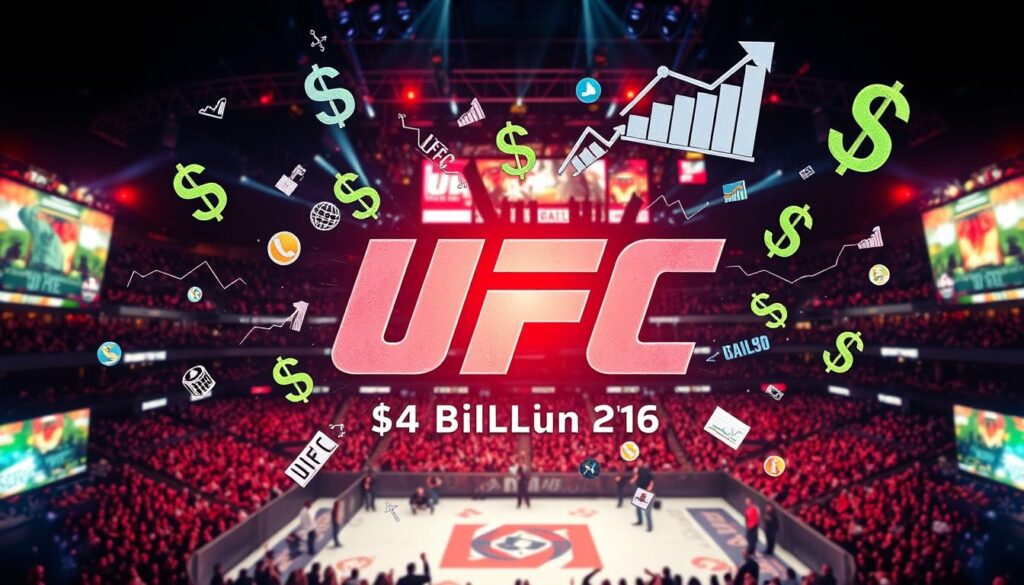
“The acquisition underscored the growing value of the mixed martial arts industry and the UFC’s market positioning.”
This sale is a key part of the UFC’s story. It opened the door for more growth and new ideas2.
The Significance of the $4 Billion Sale
The $4 billion sale of the UFC in 2016 was a big deal. It showed how much sports leagues can be worth. It also proved that combat sports can be very profitable.
This sale brought in a lot of investment. It made the UFC more famous and opened up new opportunities. Investors made a lot of money, which changed how people see sports.
The UFC’s popularity grew, reaching more people worldwide. It got bigger media deals, making it even more influential. This success drew in more sponsors and fans, thanks to smart choices after the sale.
| Key Indicators | Before Sale (2015) | After Sale (2021) |
|---|---|---|
| Annual Revenue | $609 million | $1.7 billion |
| Contracted Fighters | Unknown | 578 fighters |
| Media Rights Valuation | Not Applicable | $1.5 billion over five years |
| Number of Events | Unknown | Hundreds annually |

UFC Financial Growth Since 2016
Since 2016, the UFC has seen huge financial growth. This growth comes from broadcasting rights and merchandise sales. The rise in pay-per-view events shows more fans are watching, boosting their income.
Revenue Increase Trends
Revenue from live events has jumped a lot. Pay-per-view sales are a big part of their income, showing loyal fans. The growth is expected to keep going, making more money.
Key Factors Contributing to Growth
Several things have helped the UFC grow financially. Partnerships with big networks have made them more visible. They’ve also reached more fans by going global. The UFC’s fighters are exciting, drawing in fans with their stories.
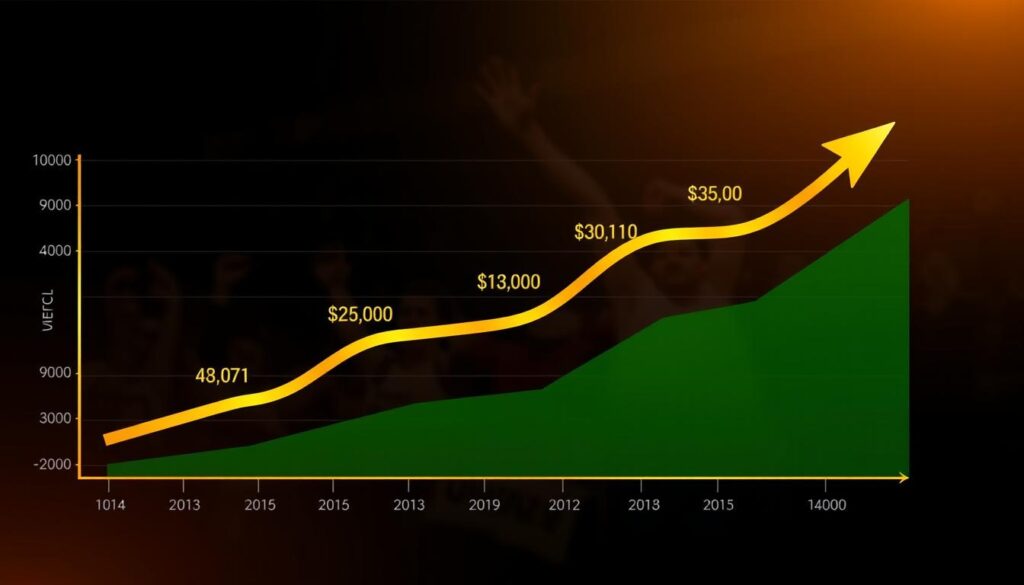
These factors have led to a big increase in UFC revenue. This puts the UFC in a strong spot in the sports world3.
UFC’s Business Development Strategies
The UFC has come up with new ways to grow its business. They focus on building strong partnerships with big brands worldwide. This helps them reach more people and grow financially.
Partnerships and Sponsorships
The UFC works with top sports brands, like Reebok and Modelo. These partnerships help promote UFC events and fighters. They also bring in more fans to watch.
For example, UFC 243 in Melbourne, Australia, drew 57,127 spectators. This shows how good these partnerships are at attracting crowds4.
Impact of Global Expansion
The UFC has expanded globally, especially in Asia and Europe. They now operate in over 165 countries and work with over 60 broadcast partners4. This growth boosts fan engagement and event attendance.
It also helps build brand loyalty across different groups. The UFC’s efforts are making the sport more popular worldwide.
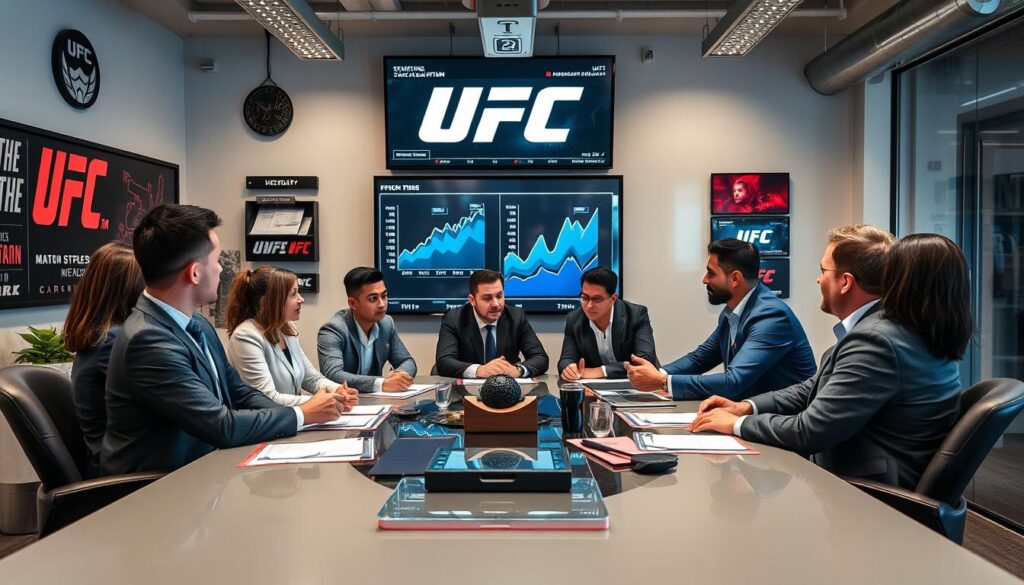
The Current UFC Market Value in 2024
By 2024, the UFC’s market value is expected to have grown a lot. It was sold in 2016 for $4 billion. Now, it could be worth nearly $10 billion, thanks to financial analyses5.
This big jump comes from more TV deals and higher sales of UFC merchandise. These gains are linked to global events1.
The UFC’s value in 2024 puts it among the sports league elite. It’s growing fast, becoming a key part of sports entertainment. It’s drawing more fans and investors1.
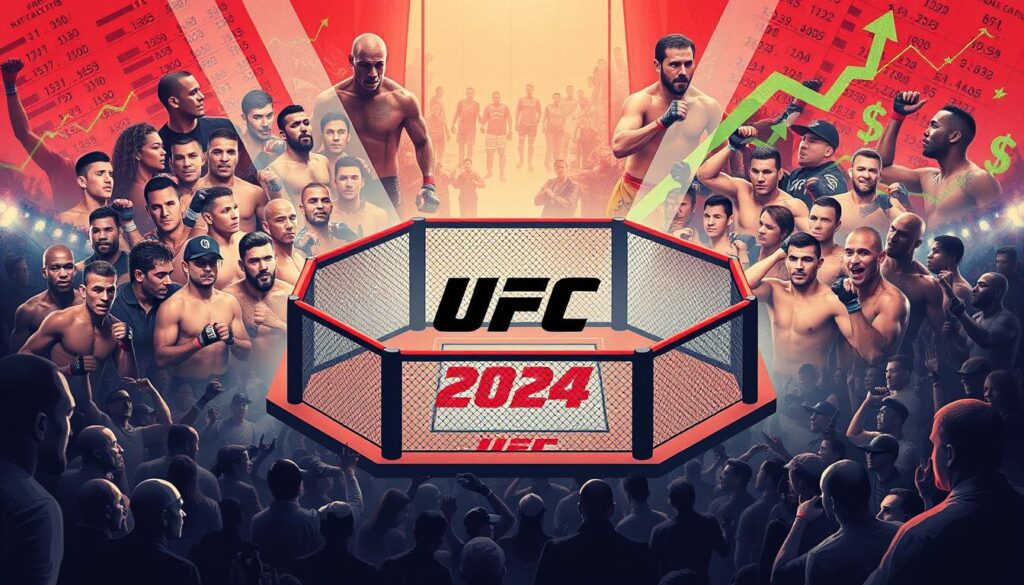
UFC Valuation and Financial Metrics
The UFC’s financial growth is impressive. UFC 306 in September at Sphere in Las Vegas set a new record with a $22 million gate. It became the highest-grossing UFC event ever6. The event sold out with 16,024 fans, showing great audience interest6.
Most ticket buyers, 89%, came from outside Nevada. This shows the event’s broad appeal6.
The UFC’s success in revenue streams is clear. UFC 306 also broke records in sponsorship, merchandise sales, and per cap expenditures. This shows the UFC’s financial health6.
The UFC uses advanced tech like live fighter heart rate tracking and Sphere Immersive Sound. This improves viewer engagement and production quality, showing a commitment to innovation6.
With 48 cameras, the most ever for a UFC event, the UFC aims for both profit and a great audience experience6.
Here’s a table showing the UFC’s financial achievements in recent big events:
| Event | Gate Revenue | Attendance | Ticket Buyers Outside Nevada | Sponsorship Sales | Merchandise Sales |
|---|---|---|---|---|---|
| UFC 306 | $22 million | 16,024 | 89% | Highest ever | Highest ever |
This data shows the UFC’s strong market valuation. It highlights growth in revenues and profitability. Tracking these metrics helps understand the UFC’s success and business model6.
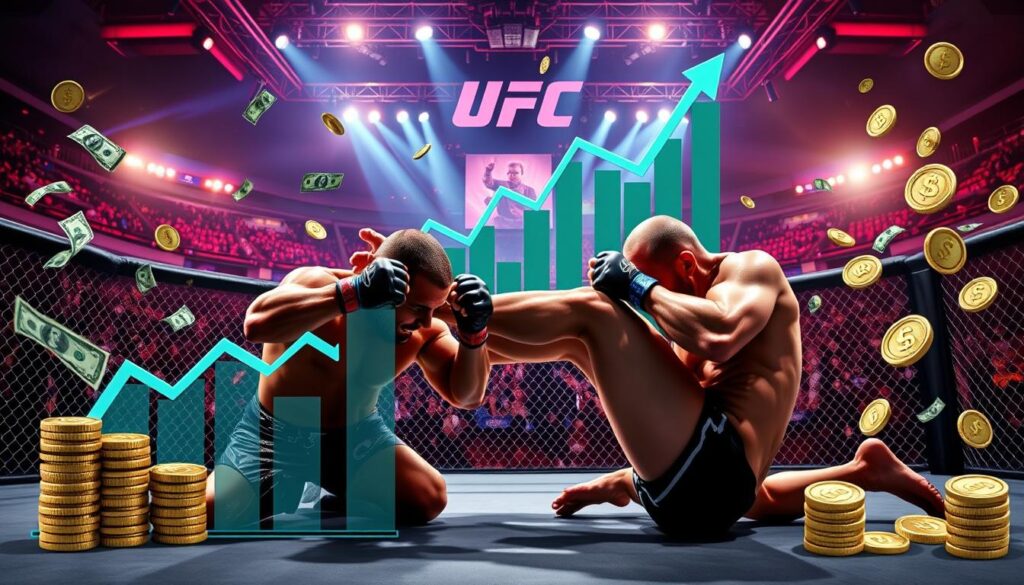
UFC Sale 4 Billion in 2016: What is the UFC Estimated Worth Now in 2024
The UFC was sold for $4 billion in 2016, a big step in its financial journey5. Today, experts think the UFC’s value in 2024 could go even higher7. This is because of more fans worldwide, better TV deals, and smart marketing.
Deals with big TV networks have brought in more money, changing the UFC’s finances5. More fans also mean more sponsors, helping the UFC grow its income.
Looking at the UFC’s future, its cultural impact and growing fan base are key5. People are excited about the UFC’s potential, thanks to its growing popularity.
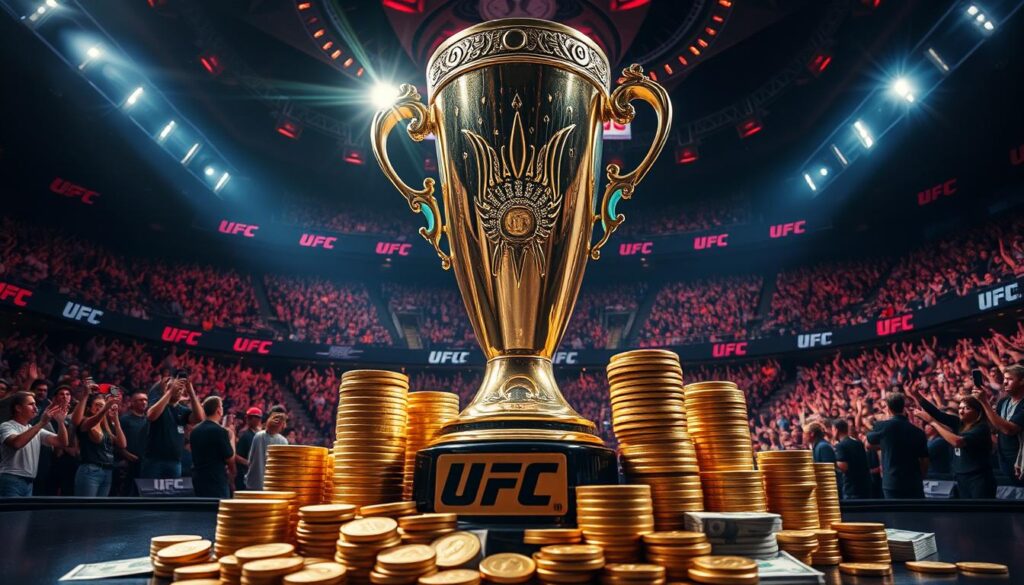
Comparative Analysis with Other Sports Leagues
Looking at the UFC compared to the NFL and NBA shows a big increase in market value and fan interest. This helps us understand where the UFC stands in the sports world.
Market Values of Competing Leagues
The UFC’s market value has grown a lot, putting it on par with top sports leagues. Here’s a table showing the market values of major leagues:
| Sports League | Market Value (in Billion USD) |
|---|---|
| UFC | 12.1 |
| NFL | 100 |
| NBA | 75 |
| MLB | 50 |
UFC Position Among Major Sports Brands
The UFC is growing fast, showing it’s becoming a big name in sports. Its increasing money shows it’s getting more popular and has a strong plan to grow. This shows the UFC is working hard to stay important in the sports world.

Factors Influencing UFC Valuation in 2024
The UFC’s value in 2024 is influenced by many factors affecting UFC valuation. Economic changes can impact its income from pay-per-view, merchandise, and live events. Knowing how consumer trends, like digital streaming, affect the UFC is key. This is because a younger audience might prefer watching fights online over in person.
Strategic choices like fighter contracts and match-ups are also crucial. The UFC’s success in getting top fighters and creating exciting matches boosts its appeal. In 2016, the UFC was bought by Endeavor Group Holdings for $4 billion. This shows its huge financial potential and global reach4.
Social media and influencer marketing are also vital. The UFC uses platforms like YouTube and Instagram to connect with more fans. This helps increase interest and fan engagement8. As trends change, the UFC’s value could go up or down. It must balance tradition and innovation in 2024.
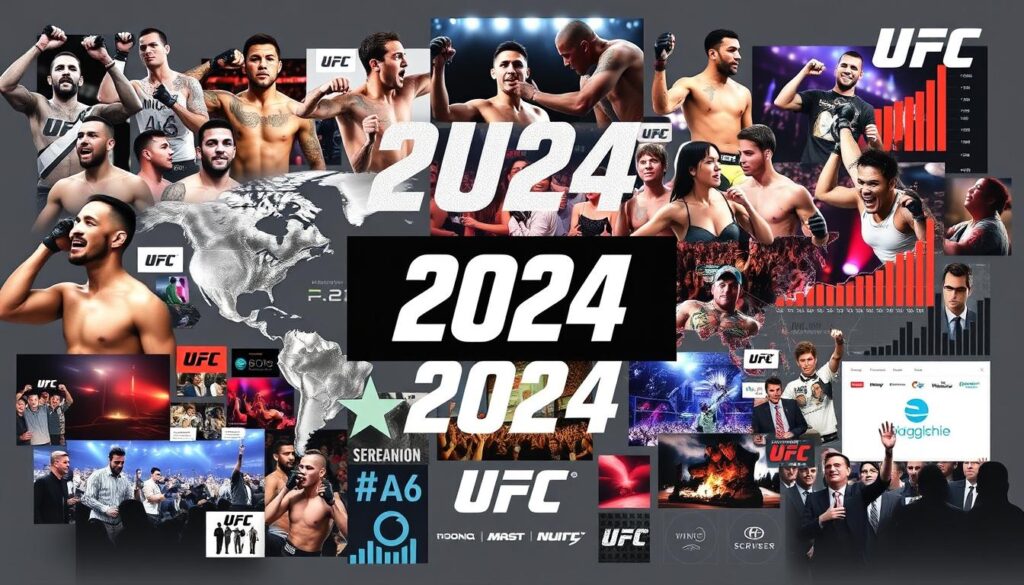
Knowing these factors helps understand the UFC’s journey in a competitive market. It shows how the UFC aims for growth while facing challenges. These factors together shape the UFC’s financial path and value in sports entertainment.
| Factors Influencing Valuation | Description |
|---|---|
| Economic Conditions | Fluctuations impact revenue from various streams. |
| Consumer Behavior | Shift towards digital streaming affects broadcast rights deals. |
| Fighter Contracts | High-profile contracts enhance marketability. |
| Social Media Engagement | Influencer marketing expands audience reach and engagement. |
Grasping these complex valuation factors gives a complete view of the UFC’s role in the sports world. It shows how the UFC adapts to changes and stays relevant.
UFC Event Popularity and Fan Engagement
The UFC’s popularity has soared in recent years, changing how we see the sport. The rise in fan engagement shows how exciting the events are. The UFC has grabbed the attention of fans all over, making a lot of money from pay-per-view events.
Pay-Per-View Revenue Insights
Pay-per-view events are key for UFC’s income. Big fights and title bouts often sell a lot. For example, the highest-grossing UFC event made $22 million, beating UFC 205’s $17.7 million record.
UFC 306 was a hit in attendance and sponsorship sales. It showed the huge financial potential of UFC events. Also, merchandise sales reached an all-time high, showing fans’ love for the brand6.
Growth in Streaming Platforms
Streaming platforms have changed how we watch UFC events. They’ve made UFC events more accessible than ever. The event at Sphere in Las Vegas sold out, showing the power of streaming.
UFC has engaged over 700 million fans worldwide. They have about 283 million social media followers. This shows their success in reaching fans through new strategies69.
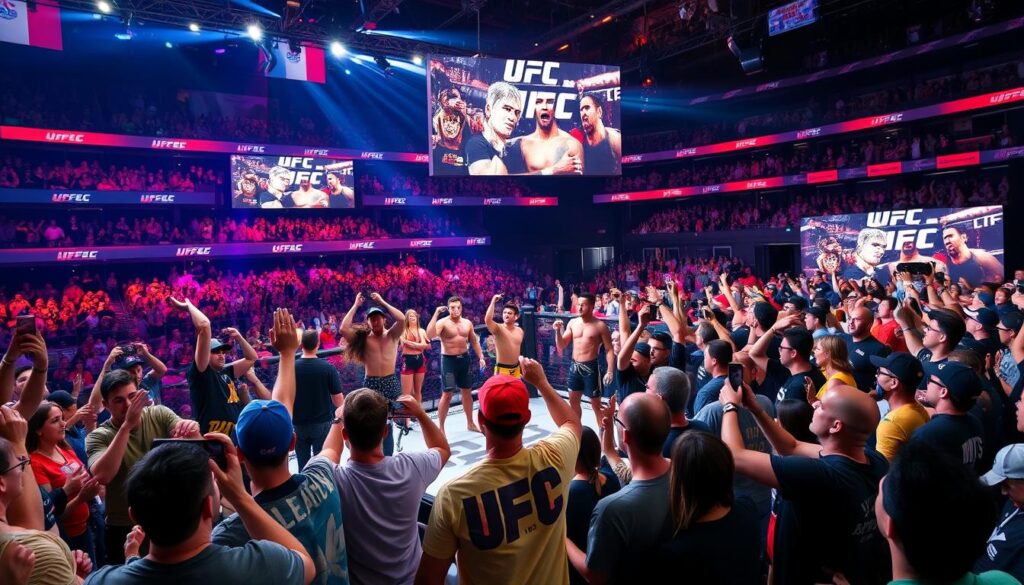
UFC Fighter Contracts and Their Impact
UFC fighter contracts are key to the organization’s financial health and competition. They help attract top fighters, boosting fan interest and sponsorships. For example, UFC 306 at Sphere in Las Vegas broke records with a $22 million gate and a sold-out crowd of 16,024, showing the power of top talent6.
UFC athletes come from over 75 countries, adding to the organization’s rich stories and rivalries. This global appeal increases the value of fighter contracts, creating more revenue streams. Notably, 89% of UFC 306 ticket buyers were from outside Nevada, highlighting its broad appeal6.
The UFC uses advanced technology to enhance fan experiences, validating the investment in fighter contracts. At UFC 306, they used 48 cameras and six broadcast mobile units for top-notch coverage6.
The financial impact of UFC fighter contracts goes beyond immediate earnings. They also shape the organization’s negotiations with broadcasters and sponsors. As the UFC grows globally, these contracts will continue to drive growth and recognition in the sports world10.
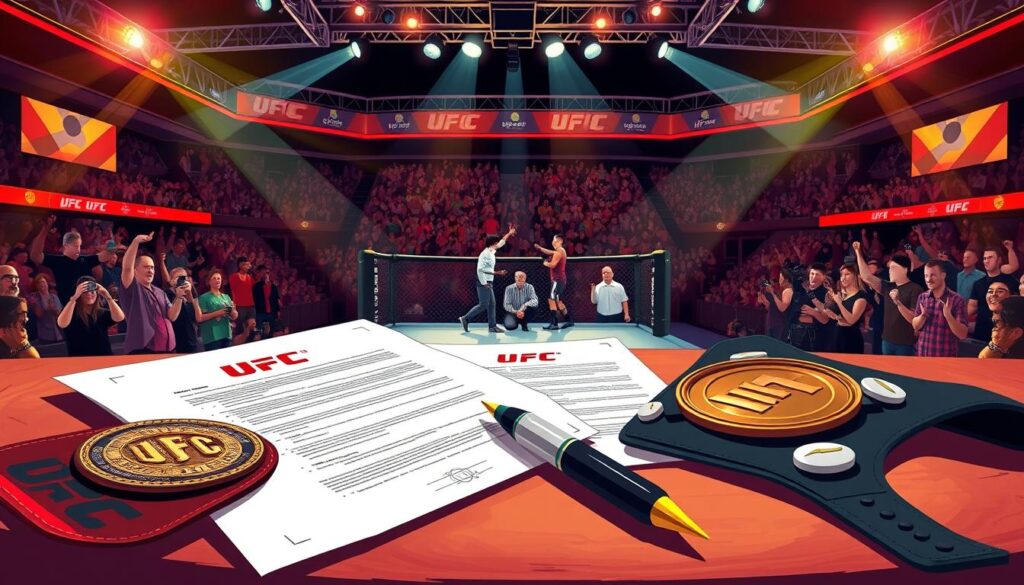
Analysis of UFC Profitability
Understanding UFC’s profitability means looking at different income sources and managing costs well. The UFC makes money from live events, licensing, and selling merchandise. Keeping costs low is key to making more profit, especially with expenses going up.
Cost Management and Revenue Streams
The UFC’s main income comes from live events and big sponsorship deals. These deals have really helped the UFC’s earnings grow. As the UFC grows worldwide, it’s working to keep costs down to stay profitable.
In 2016, the UFC made a lot of money after being sold for $4 billion. This shows how valuable it is in sports11.
Future Financial Projections
The UFC’s future looks bright, with more growth and profit expected. More people around the world are interested in mixed martial arts. This means more money for the UFC as it partners with others and grows its audience.
These trends suggest a strong future for the UFC. It will use new marketing ideas and different ways to make money. This will keep it at the top of sports entertainment12.

